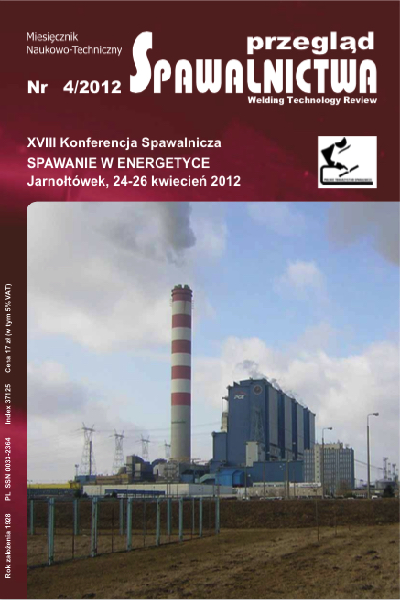Rozwój pęknięć zmęczeniowych w bimetalach stal-tytan wykonanych metodą zgrzewania wybuchowego (platerowania)
##plugins.themes.bootstrap3.article.main##
Abstrakt
W artykule opisano rozwój pęknięć zmęczeniowych w próbkach stal-tytan wykonanych metodą zgrzewania wybuchowego. Powstałe złącze wykazało nieznaczne obszary przetopione oraz mikropustki w zawinięciu fal. Próbki o przekroju poprzecznym prostokątnym poddano zginaniu przy wartości średniej naprężenia równej zeru. Dokonano punktowego pomiaru mikrotwardości w obszarze złącza. Wzrost pęknięć zmęczeniowych był cyklicznie mierzony przy użyciu mikroskopu świetlnego. W próbkach obserwowano wzrost pęknięć zmęczeniowych równolegle do przyłożonego obciążenia, którego kierunek zmieniał się na linii złącza bimetalu. Następnie obserwowano rozwój pęknięcia wzdłuż linii złącza, powodującego rozwarstwienie bimetalu. Rozwój pęknięć następował od strony stali lub tytanu w zależności od stosunku grubości składowych metali złącza. Odnotowano, że na przełomach bimetalu występują zarówno pęknięcia przebiegające po granicy ziaren, jak i transkrystaliczne.
Fatigue cracks growth in bimetals steel-titanium made by explosive welding
The paper presents fatigue crack growth in steel-titanium specimens made by the explosive welding. In the obtained joint, small joint penetration areas and microvoids were found in the wave hollow. The tested specimens of the rectangular cross-section were subjected to bending under the stress mean value equal to zero. The point measurement of hardness was performed in the joint area. The fatigue crack growth was measured in cycles by means of the optical microscope. In the specimens, the fatigue crack growth was observed in parallel to the applied loading, the direction of which varied along the interface line. Next, the crack growth was observed along the interface line when the bimetal was stratified. The crack growth started from the side of steel or titanium depending on the ratio of thickness of components of the jo- int metals. At the bimetal fractures there were both the cracks running along the grain boundary and transcrystalline ones as well.
Pobrania
##plugins.themes.bootstrap3.article.details##
Creative Commons CC BY 4.0 https://creativecommons.org/licenses/by/4.0/
Artykuły czasopisma Welding Technology Review (Przegląd Spawalnictwa) publikowane są w otwartym dostępie na licencji CC BY (licencja Creative Commons Uznanie autorstwa 4.0 Międzynarodowe). Licencja CC BY jest najbardziej otwartą dostępną licencją i uważaną za „złoty standard” w formule otwartego dostępu; jest również preferowany przez wielu fundatorów badań. Licencja ta umożliwia czytelnikom kopiowanie i redystrybucję materiału na dowolnym nośniku i w dowolnym formacie, a także zmienianie, przekształcanie lub budowanie na nim materiału, w tym do użytku komercyjnego, pod warunkiem wskazania oryginalnego autora.
Bibliografia
Pocica A., BańskI R., Szulc Z., Gałka A., Waindok P., Badania bimetalu stal austenityczna tytan wyżarzanego w różnych warunkach, Inżynieria Materiałowa, 5/2008, s. 1-4.
Crossland B., Explosive welding of metals and its application, Claredonpress, Oxford, 1982.
Nobili A., Masri T., Lafont M.C., Recent developments in characterization of a titanium steel explosion bond interface, Proceedings of Reactive Metals in Corrosive Applications Conference, Eds. Wah Chang, Albany, 1999, s. 89-98.
Król S., Bański R., Szulc Z., Gałka A., Practical aspects of structural tests of titanium-steel bonds made by explosive
cladding and exposed to thermal process loads. Advances in
Material Science, 7/2007, s. 50-56.
Thum A., Petersen C., Swenson O., Verformung, Spannung
und Kerbwirkung. VDI, Duesseldorf, 1960.
Banker J., Advances in Explosion Welding, The Handbook of
Advanced Welding, Woodhead Publishing Ltd, London, 2004.
Paul H., Faryna M., Prażmowski M., Bański R., Changes in the bonding zone of explosively welded sheets, Archives of Metallurgy and Materials, Vol. 56, 2/2011, s. 463-474.
Rozumek D., Hepner M., Wpływ mikrostruktury stopu tytanu Ti-6Al-4V na rozwój pęknięć zmęczeniowych, Inżynieria Materiałowa, 2/2005, s. 81-83.
